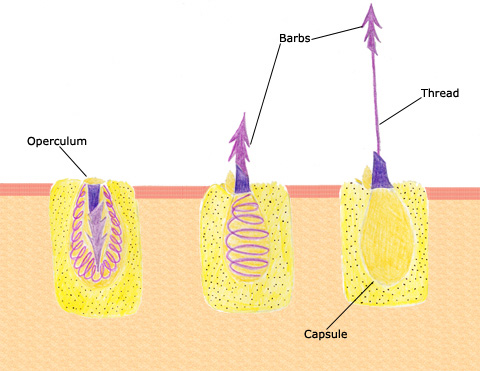What are corals?
Corals Tutorial
When corals are mentioned, most people think about clear, warm tropical seas and reefs filled with colorful fish. In fact, stony, shallow-water corals — the kind that build reefs — are only one type of coral. There are also soft corals and deep water corals that live in dark cold waters.
Almost all corals are colonial organisms. This means that they are composed of hundreds to hundreds of thousands of individual animals, called polyps. Each polyp has a stomach that opens at only one end. This opening, called the mouth, is surrounded by a circle of tentacles. The polyp uses these tentacles for defense, to capture small animals for food, and to clear away debris. Food enters the stomach through the mouth. After the food is consumed, waste products are expelled through the same opening.
Most corals feed at night. To capture their food, corals use stinging cells called nematocysts. These cells are located in the coral polyp’s tentacles and outer tissues. If you’ve ever been “stung” by a jellyfish (a relative of corals), you’ve encountered nematocysts.
Nematocysts are capable of delivering powerful, often lethal, toxins, and are essential in capturing prey. A coral's prey ranges in size from nearly microscopic animals called zooplankton to small fish, depending on the size of the coral polyps. In addition to capturing zooplankton and larger animals with their tentacles, many corals also collect fine organic particles in mucous film and strands, which they then draw into their mouths.

Most corals are made up of hundreds to hundreds of thousands of individual coral polyps like this one. View a detailed diagram and a description of a polyp's anatomy.

Nematocysts are special stinging cells used by coral polyps to capture food. View a diagram of a nematocyst cell’s anatomy and how it works.
Corals Lessons
- Welcome
- What are Corals?
- Zooxanthellae What's That?
- How Do Stony Corals Grow?
- How Do Coral Reefs Form?
- Where Are Coral Reefs Found?
- How Do Corals Reproduce?
- Importance of Coral Reefs
- Natural Threats to Coral Reefs
- Anthropogenic Threats to Corals
- Coral Diseases
- Protecting Coral Reefs
- References
- Roadmap to Resources
- Subject Review (PDF)
